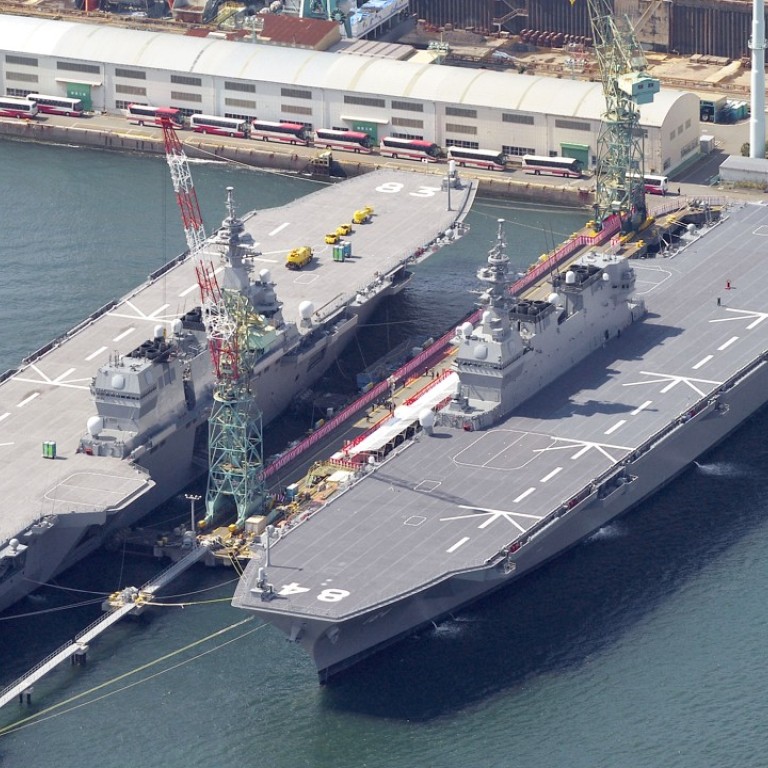
Japanese, British warships carry out joint exercise in Indian Ocean in latest show of strength to China
Drills provide ‘opportunity for [Tokyo] to strengthen cooperation’ with allies, Japanese naval commander says
Japan’s biggest warship joined a British frigate for naval drills in the Indian Ocean on Wednesday as the latter was en route to the contested South China Sea, in the latest sign of Tokyo’s growing involvement in efforts to counter Beijing’s influence in the region.
The deployment of the Japanese helicopter carrier Kaga alongside the HMS Argyll came after the United States said it had sent B-52 bombers to conduct transit operations in the South China and East China seas.
Pentagon spokesman Lieutenant Colonel Dave Eastburn said on Wednesday that the heavy bombers “took part in a regularly scheduled, combined operation in the East China Sea” on late Tuesday after flying through “international airspace over the South China Sea” earlier in the week.
Britain, Japan and the United States have found common cause in countering growing Chinese influence in the region, which they worry could put commercial sea lanes linking Asia with Europe, the US and elsewhere under Beijing’s sway.
“We have traditional ties with the British navy and we are both close US allies,” Kenji Sakaguchi, the naval commander of the Kaga group’s four helicopters. “These drills are an opportunity for us to strengthen cooperation.”
The more frequent presence of the British navy in the region was a chance for the two sides to train more closely together, he said.
US flies B-52 bombers over South and East China Seas as tensions soar over trade
The Argyll, Kaga and its destroyer escort, the Inazuma, practised formations on calm seas in the Indian Ocean close to commercial sea lanes plied by container vessels and oil tankers. Three helicopters from the Japanese carrier hovered above, monitoring the drill.
After crossing the South China Sea, the Argyll will operate in waters around Japan, including a stint monitoring sanctions imposed on North Korea by the United Nations with the aim of getting Pyongyang to give up its nuclear weapons and ballistic missiles.
Foreign warships in South China Sea ‘causing trouble’, Beijing’s ambassador to Britain says
The Argyll’s arrival in the region comes after Britain’s amphibious assault ship HMS Albion last month challenged Beijing’s territorial claims in the South China Sea on its way to Vietnam from Japan by sailing close to Chinese bases in the Paracel Islands during a freedom of navigation operation.
China dispatched a warship and helicopters to counter the British presence and warned London that similar actions in the future could endanger talks for a possible trade deal that Britain is seeking as it prepares to leave the European Union.
The Japanese military has been stepping up its presence in Southeast Asia. Last week, the defence ministry in Tokyo confirmed that the submarine Kuroshio had joined the Kaga, Inazuma and another destroyer, Suzutsuki, in an anti-submarine warfare exercise in the South China Sea on September 13.
Japan’s Murasame-class JS Akebono destroyer, with its two SH-60K patrol helicopters, is making a three-day port visit to the Philippines.
Japan challenges China with submarine military exercise in South China Sea
Collin Koh, a research fellow with the Maritime Security Programme at the S. Rajaratnam School of International Studies, said Japan had in recent years been reaching out to other nations, including Britain, to counter China’s influence.
“If we look at it from a trilateral perspective involving Japan, the US and the UK we can expect interoperability between forces, which may not take too long to build,” he said, adding that there would be more cooperation among the three militaries.
“No longer bilateral exercises always stay bilateral. From time to time, depending on the topics of the joint training engagements, a third party or third parties can be roped in.”
Additional reporting by Reuters and Agence France-Presse


